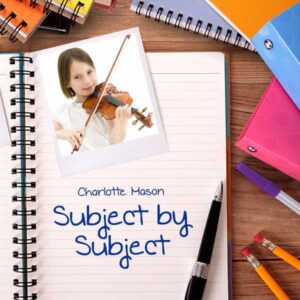60-day returns • free shipping on USA orders $129+


Charlotte recognized that not every student would become a virtuoso, but she understood that beauty and enjoyment can be added to life by appreciating good music, singing, and learning the basics of playing music. Here’s how to approach music in a Charlotte Mason way.
Music Appreciation
Simply choose one composer and play his or her music around your house for several weeks. You can play the music in the background while you are all eating lunch or working on handicrafts or running errands in the van. You can play it during rest times or while the children are going to sleep (provided the composer was not too rambunctious!). You don’t need fancy introductions or elaborate explanations; just tell the children which composer’s work you are playing.
During those weeks of listening, if you can find a good living biography on your selected composer, read it aloud to the children and have them narrate it. Enter the composer in your Book of Centuries. Then once each week, gather to spotlight one of the composer’s works. Our Music Study with the Masters portfolios provide biographies, dates, spotlights, and great music recordings, so you will find music appreciation easy to do.
At the end of those weeks, your children will have a pretty good feel for that composer’s style. Then you can choose another composer and go again. It’s simple, yet effective!
Singing
Charlotte’s students had fun with singing in short sessions a couple of times a week. They used the sol-fa method. If you have watched the movie The Sound of Music, you’ve heard the sol-fa method used to teach the song “Do, a Deer.” The complete method has hand signals, too, and is a great way to teach children to listen closely and to sing in harmony easily.
Don’t worry if you aren’t Julie Andrews and don’t know how to teach your children to sing in harmony; they can still enjoy singing along to recorded music, singing while playing, and singing together as a family. The key is to encourage singing.
One great way to do that is through Hymn Study. Simply select one hymn and sing it together, all the stanzas, until everyone knows it well. You might sing it a couple of times a week for a few weeks, then add another hymn and alternate. It’s a great way to make sure the rich heritage of God-honoring hymns is passed to the next generation and to enjoy singing together. Singing the Great Hymns provides lyrics, music scores, and simple piano recordings for more than 70 hymns.
Playing an Instrument
Piano was taught to all of Charlotte’s students. Whichever instrument you or your children select to learn, keep in mind the facets of a well-rounded instrumental education. Charlotte encouraged parents to make sure any music lessons included three aspects: music theory and ear training, as well as instruction on the instrument itself.
And if at all possible, give your child an excellent teacher right from the start. Remember, you are laying the foundation as well as cultivating your child’s taste for the fine arts. Charlotte said: “If possible, let the children learn from the first under artists, lovers of their work: it is a serious mistake to let the child lay the foundation of whatever he may do in the future under ill-qualified mechanical teachers, who kindle in him none of the enthusiasm which is the life of art” (Vol. 1, p. 314).
Remember, you’re not doing everything every day. With the wide range of subjects to draw from in a generous curriculum, you can enjoy a wonderfully diverse week with some delightful variety each day.
Podcast: Play in new window | Download
